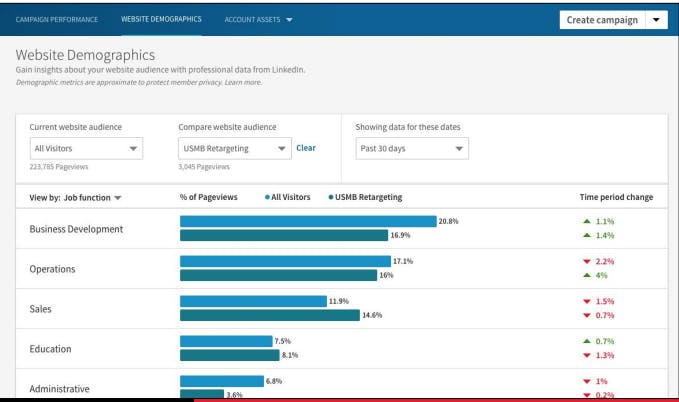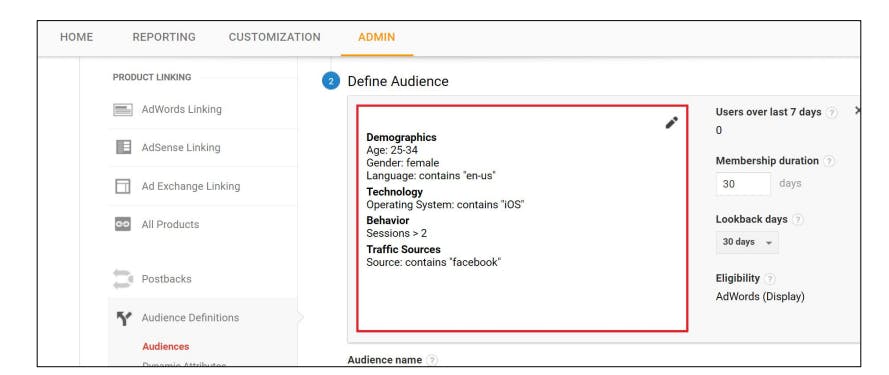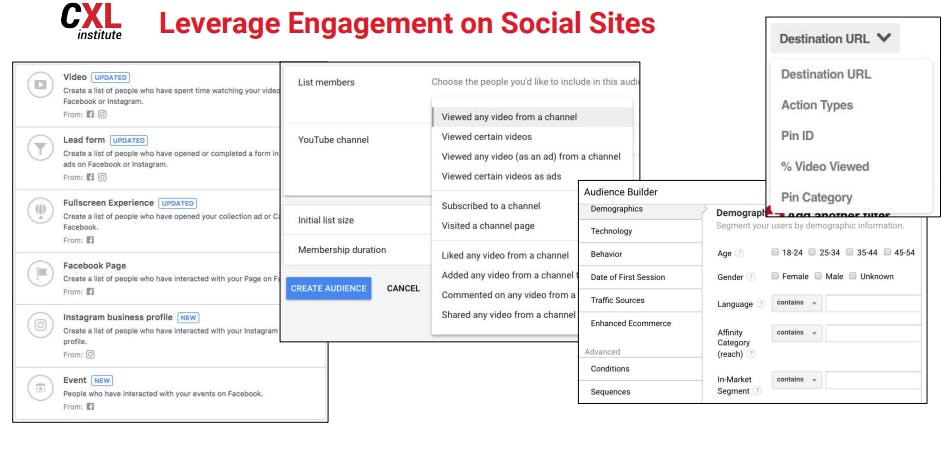In PPC advertising, keywords are usually the focus of audience definition and targeting. This could be due to the popularity of search engines, and their suitability in matching a prospect’s query to buying intent.
But there's an evolution across PPC service platforms which is creating more emphasis on people as opposed to abstract targeting parameters. While keywords are an important targeting option, there's more reason to target people regardless of whether they are actively searching for an offering or showing intent.
In this review, we would be exploring how to find the right audience using existing tools, how to create good retargeting parameters, and how to integrate parameters across Facebook, LinkedIn, Google Ads etc., so as to exploit targeting options that one channel possesses but others may lack.
Here's the outline
Part 1
- Finding your target audience in existing tools
- Creating good retargeting parameters for remarketing, exclusion and lookalike modeling
Part 2
- Intent-based parameters for remarketing
- Utilizing parameters in the Search Network
Part 3
- Building a funnel with parameters
- Leveraging your audience across channels
Finding your target audience in existing tools
The vast majority of businesses may not have the funds to conduct detailed persona studies, nevertheless, they know their clients exist among the hordes of searchers and social media users.
How then can they find their best clients?
The first step would involve talking to different stakeholders within the company and exploring data on the characteristics of the customers that already exist, especially in your CRM.
In conversing with stakeholders, the list of stakeholders should be broad due to the potential for divergent views e.g. those who do cold calling and marketing executives may have different opinions on who the ideal customer is due to differences in customer exposure.
a) From the digital side of things, exploring the source of site visitors is a powerful method of constructing the targeting parameters for your ideal parameters. To start along this path, you can observe referral traffic in google analytics, while plotting it against metrics like goal completions, pages per session, time on page and other metrics that are indicative of the visitor's interest.
b) From an audience perspective we can create custom groupings and remarketing lists from these referral sources.
c) From the display standpoint, we can explore direct ad placements on these referring domains or create custom affinity parameters based on these referral sources.
d) Another alternative is to go to the interests section in google analytics. This section hosts in-market segments and affinity categories. Digging deep reveals user characteristics that could feed audience definition
e) Another cool idea is to use search terms in the site-search tracking report to build a targeting audience or to get keyword ideas
In addition to google there are other social tools (and pixels) that can provide data to aid your targeting decisions. One of these is the Facebook Audience insights. This platform can show data on page likes relative to your own page. Using this data, you could create display ad placements or explore patterns between data segmentation in Facebook vs google.
With LinkedIn's pixel, we can get data like.

Creating good retargeting parameters for targeting, exclusion and lookalike modeling
There are more types of audience lists beside those who've been to a website without converting. Setting of these lists is important not just for retargeting but for controlling the audience sizes by using either exclusions or by expanding with lookalike parameters.
Audience creation in platforms like google ads can be done based on
- Website visitors
- App users and engagement
- YouTube users and their engagement metrics
- Customer match based on selected rules
These audience segmentation options are generated from the PPC cookie on your website. In cookie configuration, marketers usually default to a 90 day membership list of people who did not hit a thank you page i.e. did not convert. This default cookie set up muddles up the retargeting process due to flaws like:
90 days is too long to guarantee the relevance of large swathes of the audience
The 90 day list doesn't give much insight on performance. Since customers in the list are on different stages within their own unique buying journey
Not all non-converters over a 90 day period are equal. They didn't convert for different reasons and should be retargeted differently
To get around the performance issues of a potentially faulty retargeting list, adopt measures like
- Leveraging time in retargeting
- Utilizing cookie lengths to your advantage
- Create meaningful segmentations in retargeting lists**
Leveraging time in retargeting To achieve this, the time lag report can sometimes be of help since it shows the time lapse between an impression and a useful action on the website. It can indicate how long people are willing to return and convert on a single call to action, while comparing how different calls to action relate to each other along a time scale. Nevertheless, this report isn't directly actionable since it cannot be used to directly reconfigure a PPC campaign from within the AdWords interface
Utilizing cookie lengths to your advantage
This can be done by breaking up a 90 day list into three separate parameters from within the remarketing cookie. This creates three clusters with one that's set for 30 days, one that's set for 60 days, and one that's set for 90 days. This creates three parameters nesting within each other. They're just different degrees of the same audience with the 30 days being the most specific third of the audience, usually,60 days being the next, and then 90 days being kind of that outer rim that would encompass everybody that's in that audience.
After creating these tripartite nests, you can then leverage it by reducing the call to action price as time passes.
Note: price in this context is more than just a monetary amount. It refers to the amount of effort the CTA requires from the visitor before a conversion can be registered e.g downloading a pdf < giving an email < filling a form to book a demo < inputting credit card details Create meaningful segmentations in retargeting lists
This can be achieved by converting each stage of the funnel or user behavior signals into a separate subset of the general retargeting list.
E.g if someone has only been on the women's side of an ecommerce site, we can assume that it is a woman and create a separate targeting audience based on these details.
How to create parameters in google analytics
- Go to the admin section in your analytics account
- Under property settings click on audience definitions
In audience definitions, you can ignore the default options and create your own based on
Demographic parameters
- Technology parameters
- Behavior parameters
- Traffic Source parameters

The same can be achieved using social media platforms e.g.

Prompts for Retargeting Lists
● What actions are desired on your site?
● What are your conversion actions?
● How long would someone need to stay on your site to understand your product?
● Are there pages that indicate a greater chance of purchase?
● Are there multiple stages to your purchase cycle?
● How long is your sales cycle?
● What constitutes a large purchase?
● Do you have repeat customers or only one time buyers?
● Do you need to target people within certain timing windows?
● How engaged is an average customer on your site?
● Who are your target personas?
Building Audiences for EXCLUSION
We don't only build lists because we want to target people. In campaign structure, we want to be able to also exclude them from campaigns, and there are some kind of meaningful ways to do that.
Fore example, we can start by looking at cookies and customer uploads
We can use cookies, meaning somebody has hit our Google Ads pixel, our Facebook ads pixel etc. That's what we mean by cookie. They have been cookied and they're part of an audience created based on the pixel.
Customer uploads are when we take the list of email addresses (Google Ads and Facebook also have the expanded match for names, city and state) and match them to individual users in a CRM
Each one of those has their strengths, each one also kind of falls down, which is why I think you need to use both of them together to have a full audience exclusion piece.
For B2B specifically, you usually want to exclude people from your prospecting campaigns that have already engaged with you. They've already done the action you wanted them to take so we need to exclude them, and that's why you need to use both uploads and cookies because:
Dynamic Lists: Cookies are dynamic and offer real time audience updates.
Tracking Hiccups and cookie length: Due to tracking hiccups from misconfigured pixels, overly long cookie lengths, cross-device tracking limitations within the pixels etc. the exclusion list may become imperfect e.g. The longest cookie duration is Google at 540 days. So, if somebody converted, and you still want to exclude them from your campaigns, you no longer can with a cookie list after 540 days, you need to use a customer upload list to do that
Unconventional Customers: unconventional customers are those who came from word of mouth, have never visited the site and can't be excluded via a pixel. In other instances we can build exclusion lists based on web interaction data such as
Job Hunters: those who visited your site but spend undue amounts of time in your careers page
Quick Bounces: those with abnormally low levels of time on page or session duration metrics.
Prompts for Negative Retargeting Lists
● What actions are undesired on your site?
● What actions are undesirable on your site?
● Who are your visitors that have converted?
● How short of a video is too short?
● Are there pages that indicate a lower propensity to purchase?
● What constitutes a small purchase?
● Did this person return the product?
● How long until you determine someone is no longer interested?
● What constitutes a poor visit to your site?
● Who are your people outside of your target personas?
Read: How to Master PPC Targeting
Building Audiences: Expansion
Retargeting audiences helps you expand?
It seems a little counter-intuitive, right? But it's something that is really important if you want to be able to leverage the algorithms that are in our platforms. Pretty much all platforms that we utilize nowadays have some form of Similar Audience or Lookalike function. They might call it something different. Google Ads calls it Similar Audience. Facebook calls it Lookalike; Quora has some. This means they analyze your audiences, then curate lists of users who exhibit similar behaviors to those users in your list
Note: lookalike algorithms are just like any other machine, you put good data in, you're going to get good data out. What we want to do is put in meaningful patterned lists. So, we've got to be able to find those patterned lists of people, put them in a Lookalike algorithm, and out of it, it's going to come some strong modeling
Other things to think about
- If your list is too small, there’s no discernable pattern.
- If your list is too large, there’s no discernable pattern.
- On Facebook, you can make a Lookalike from any size audience (Facebook requires 10-50K as a root size for a meaningful look alike audience)
- On Google, they will automatically create similar audiences for you once a pattern of behavior is detected.
Summary Audience targeting and segmentation are central to PPC targeting especially if we want to take buying intent and ad relevance into consideration. This review is part 1 and explores only 30% of the configuration ideas than PPC masters use. In part 2 and 3, we'll cover other aspects such as
- Intent-based parameters for remarketing
- Utilizing parameters in the Search Network
- Building a funnel with parameters
- Leveraging your audience across channels

